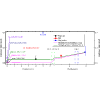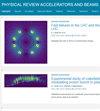激光驱动宽能谱质子束的辐照度增长分析
IF 1.5
3区 物理与天体物理
Q3 PHYSICS, NUCLEAR
Physical Review Accelerators and Beams
Pub Date : 2024-04-22
DOI:10.1103/physrevaccelbeams.27.041303
引用次数: 0
摘要
随着高梯度激光等离子体加速技术的快速发展,将其应用于实际应用已成为当务之急。然而,要实现从 "加速 "到 "加速器 "的转变,就需要有一套光束线系统来根据不同的辐照要求精确控制光束参数。激光加速质子束的特点是原始源尺寸为微米级,发射率低至 0.004 mm mrad [T. E. Cowan 等人,Phys. Rev. Lett.然而,由于能量分布广、发散大,其初始超低发射率会在随后的传输过程中迅速增加。这表明,激光驱动质子的光束线设计具有挑战性,与传统加速器有很大不同。作为光束线设计的基本参数,我们从理论上推导出了激光驱动质子在漂移空间和聚焦元件中的辐照度增长规律。结果表明,光束辐照度随着能量扩散和发散角的平方而急剧恶化。这些理论计算在实验和模拟中都得到了验证。这项工作有助于设计追求高传输效率和消色差能力的后续光束线。本文章由计算机程序翻译,如有差异,请以英文原文为准。

Emittance growth analysis of laser-driven broad energy spectral proton beams
With the rapid development of high-gradient laser plasma acceleration, implementing it in practical applications has become a priority. However, to go from “acceleration” to “accelerator,” a beam line system is required to accurately control the beam parameters according to different irradiation requirements. The laser-accelerated proton beam is characterized by a micron-scale original source size and a small emittance as low as 0.004 mm mrad [T. E. Cowan et al., Phys. Rev. Lett. 92, 204801 (2004)]. However, due to the broad energy spread and large divergence, its initial ultralow emittance will increase rapidly in the subsequent transmission process. This indicates that designing a beamline for laser-driven protons is challenging and differs significantly from that of a conventional accelerator. As a fundamental parameter for beam line design, we have theoretically derived the emittance growth law for laser-driven protons in both drift space and in a focusing element. The results demonstrate that the beam emittance deteriorates sharply with the energy spread and the square of the divergence angle. These theoretical calculations have been verified both in experiments and simulations. This work is helpful for designing subsequent beam lines that pursue high transmission efficiency and achromatic ability.
求助全文
通过发布文献求助,成功后即可免费获取论文全文。
去求助
来源期刊

Physical Review Accelerators and Beams
Physics and Astronomy-Surfaces and Interfaces
CiteScore
3.90
自引率
23.50%
发文量
158
审稿时长
23 weeks
期刊介绍:
Physical Review Special Topics - Accelerators and Beams (PRST-AB) is a peer-reviewed, purely electronic journal, distributed without charge to readers and funded by sponsors from national and international laboratories and other partners. The articles are published by the American Physical Society under the terms of the Creative Commons Attribution 3.0 License.
It covers the full range of accelerator science and technology; subsystem and component technologies; beam dynamics; accelerator applications; and design, operation, and improvement of accelerators used in science and industry. This includes accelerators for high-energy and nuclear physics, synchrotron-radiation production, spallation neutron sources, medical therapy, and intense-beam applications.
 求助内容:
求助内容: 应助结果提醒方式:
应助结果提醒方式:


